Hi,
This is my article on Magritte's work with paintings as examples:
Background
Styles
Certainly Rene Magritte had different styles during his lifetime although he is known for his detailed realistic style. Until the mid 1920s his work was more abstract and cubist in style and eventually he developed his realistic style which he consistently maintained until the 1940s when he briefly experimented with impressionism (1942-1947) and later that decade his vauche period (1948). I'll gives example of his styles and paintings later on in this article.
The next section will examine the political and artisitic climate that led to Magritte's development and eventual adherence to surrealism.
Cubism
Cubism is the avant-garde art movement pioneered by Pablo Picasso and Georges Braque in the early 1900s. Other French cubists including Fernand Leger and Amedee Ozenfant had an influence on the early style of young Magritte who studied art in Brussells. He was inspired by a lecture from abstractionist Theo van Doesburg titled De Stijl (The Style) in February 1920 and studied related futurism and purism. Some of his paintings including the Blue Cinema done in 1925 have an Art Deco influence. See examples below.
Dada
Before surrealism Magritte was aligned with the Dada movement in Europe that was a reaction to the First World War (1916-1924). Many Dadaists believed that the 'reason' and 'logic' of bourgeois capitalist society had led people into war. They expressed their rejection of that ideology in artistic expression that appeared to reject logic and embrace chaos and irrationality (nihilism).
Giorgio de Chirico
One artists that embraced chaos was the Italian painter Giorgio de Chirico, who alos lived in Paris several times. From 1914 to 1925 de Chirico painted bizarre, faceless mannequins and juxtaposed wildly unrelated objects in his still lifes, a technique adopted by the surrealists. When Magritte became aware of Giorgio de Chirico work in 1925, he rejected the early influences of Cubism (popular from 1907-1919), Futurism and Purism. He adopted a style of detailed realism to depict subject matter that was not real. His "The Two Sisters" (1925) based on Giorgio de Chirico and "The Shooting Gallery" mark the turn in style.
Max Ernst
The other artist that influenced Magritte in the early 1920s that led to his first surreal works was the German artist Max Ernest. Brought into the French Dada circle in 1922 by French poet Eluard, they worked on a cycle entitled Les Malheurs des Immortels, a series of collage pictures made of scraps of illustrations cut out from old books.
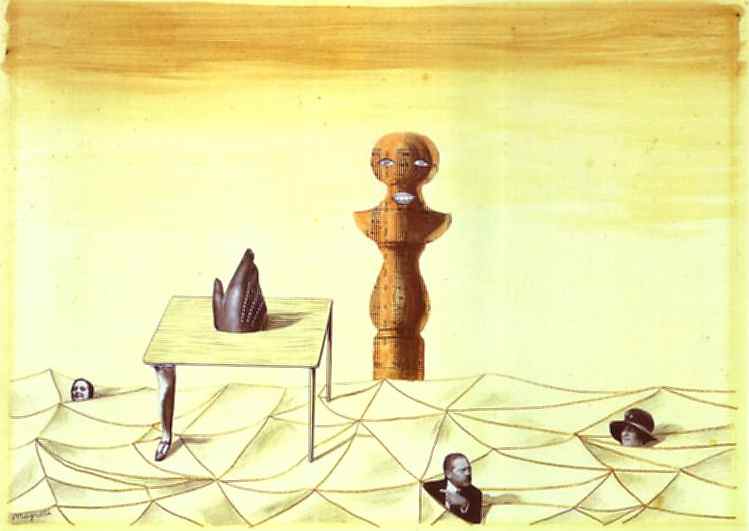
This untitled collage is one from circa 1925 pre-dating his Lost Jockey.
According to Magritte His Lost Jockey (1925), below, was his first surreal painting.
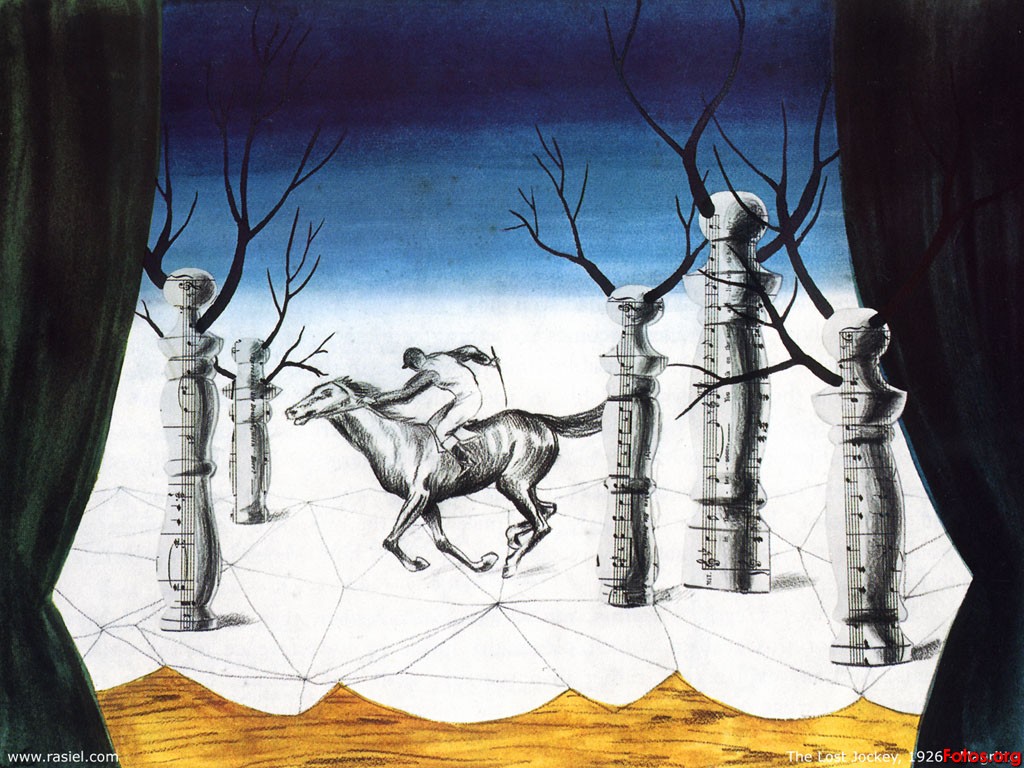
The Lost Jockey- 1925
Surrealism
E.L.T. Mesens, together with Magritte, contributed to the final issue of Picabia's Dada review 391 (October 1924) about the same time Andre Breton published his first Manifeste du Surréalisme defining the movement 'once and for all' as he put it: "SURREALISM, noun, masc. Pure psychic automatism by which it is intended to express either verbally or in writing, the true function of thought. Thought dictated in the absence of all control exerted by reason, and outside all aesthetic or more preoccupations."
The dadaists joined forces behind Breton and became surrealists. The Paris group included Andre Breton, Paul Eluard, Max Ernst, Antonin Artaud, Andre Masson, Raymond Queneau, Joan Miró, Max Morise, Pierre Naville, Mathias Lübeck, Jacques-André Boiffard and Georges Malkine. The group launches a new periodical, La Revolution Surrealiste. A Bureau of Surrealist Enquires is opened in Paris.
The Belgium dadists started their own group lead by Paul Nouge. It included Rene Magritte, E. L. T. Mesens, Camille Goemans, Marcel Lecomte and others.
Surrealism became divided into two main artistic groups. Magritte was from the Veristic Surrealism group that includes Dali and Ernst. This group used meticulous realism to portray the imagery of the subconcious mind.
The other branch of surrealism that included automatic drawing and writing stems from André Breton definition of surrealism as "Pure psychic automatism." Automatic drawing was a free form expression developed by the surrealists, as a means of expressing the subconscious. Andre Masson and Miro remain prime examples of the automatism movement.
Magritte's Surrealism
To understand the nature and effect of Magritte's work you simply must understand the nature of what makes a joke work. A joke combines an element of surprise, what you expect to hear is not what you hear. It combines the unexpected with the predictable. In Magritte case what you expect to see is not what you see. The familiar expectations have been intentionally altered.
A quote from one of Magritte’s letters to Paul Nouge (1927) helps explain: "I have found a new possibility things may have: that of gradually becoming something else—an object melting into an object other than itself... In this way I obtain pictures in which 'the eye must think' in a way entirely different from the usual."
The following are seven different techniques Magritte used in his paintings:
1) Altering the familiar; Juxtaposition of objects: Surrealism is the depiction of the images found in the subconscious mind, whether the images are dreams or unconscious thoughts. Characterized by fantastic imagery and incongruous juxtaposition, these images confound the viewer.
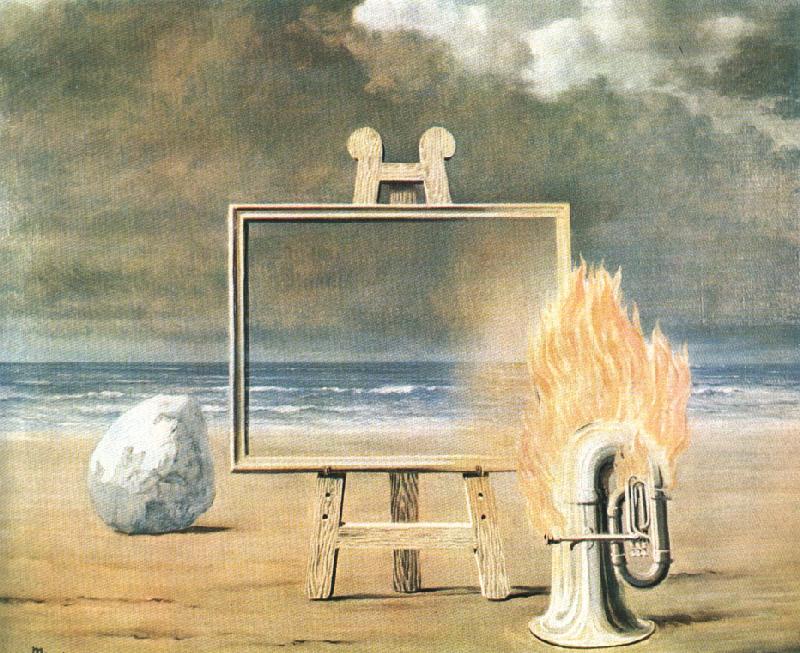
La Belle Captive- 1926
Above is one of Magritte's paintings in his new style. It combines illusion (a canvas that is the exact image of the backround beach scene) with the incongruent images of a burning tuba, an easel and a boulder, none of which are typically found on a beach.
2) Mutation of objects- Metamorphosis: In 1927 Magritte painted "Discovery" depicting a female nude whose skin has morphed into wood grain. Attributing human characteristics to animals, and objects is called “anthropomorphism.”
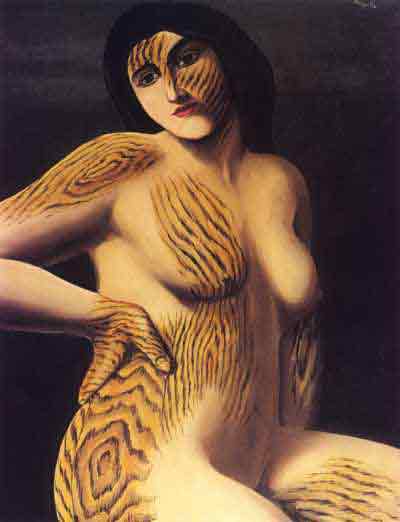
Discovery- 1927
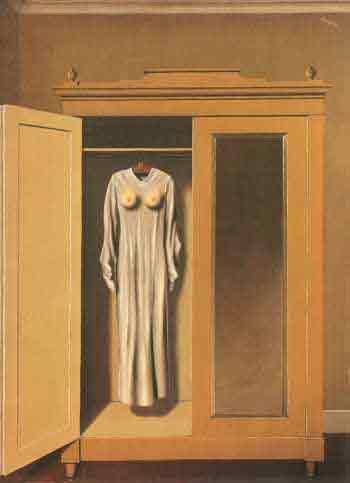
Hommage to Mack Sennett 1934
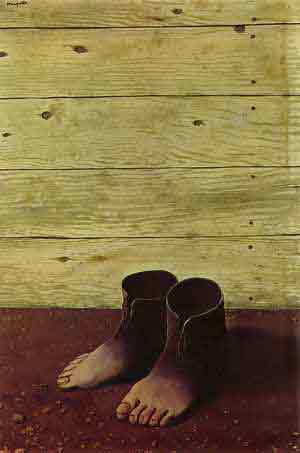
The Red Model II 1939
3) Fragmentation: Delusions of Grandeur is one example of Magritte fragmenting an image (in this case it's a woman's torso). La Fin des contemplations 1927 is another example of fragmentation frequently used as the shattered glass images either in a mirror or in other paintings glass windows.
The Eternally Obvious, 1930 and new version done 1948, is one of René Magritte's best examples of fragmentation. The painting is done on five separate framed panels, oil on canvas laid on board. Magritte painted the body of a naked blonde model, cut from the canvas the body's five choicest bits, surrounded them in gold frames, and reassembled the figure with blank spaces in between on a sheet of glass. This work is a variant of the artist's famous, same-titled prototype from 1930 for which his wife Georgette posed. In that earlier work, Georgette's face is seen in three-quarter view, she stands in a contrapposto stance, and her body is not as rigidly aligned frontally as in this later work, for which the artist chose a younger model with firmer breasts. Magritte plays tricks with our perception in these "picture-objects," whose fame—that of the earlier version—coincided with its role in the cult of the Surrealist object in the 1930s. Although the body is truncated, we automatically fill in the missing areas and see a "complete" nude woman, never mind that her arms and hands are missing.
4) Creation of icons or symbols: An icon is just a symbol. For Magritte certain obsessive images became icons: his famous bowler hat, the dove, curtains, the rose, the bell, the apple, the burning tuba, the mirror, the leaf, the owl, the bilboquet or balluster, the candle, the egg, a canvas painting, and even words themselves.
In 1926 Magritte introduced the balluster (a wooden upright support, such as a furniture leg sometimes resembling a chess bishop) as his icon and many of his early works (See above: The Lost Jockey) have ballusters.
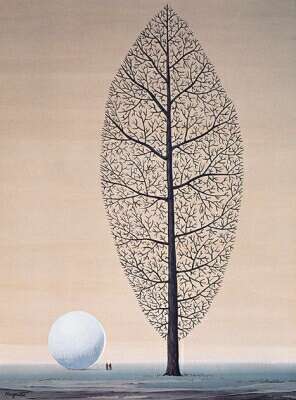
Above are two of Magritte's icons: a ball and a leaf. These giant icons dwarf the two people standing between them.
Iconologic, simply put, means thinking through images. By introducing these icons in various settings Magritte created mystery. The mystery of the image was an important concept for Magritte. What does the image/object/icon mean? Is it real? Can we really understand the unknowable?
By repeating these icons throughout his art he gives power to certain images that are normally quite ordinary. Repeating icons in art is a form of obsessive behavior. Salvador Dali was perhaps the master of neurotic/obsessive images.
5) Altering perspective:
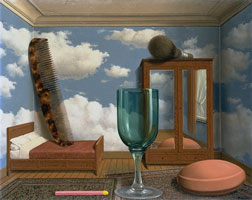
Personal Values- 1952
6) Illusion:
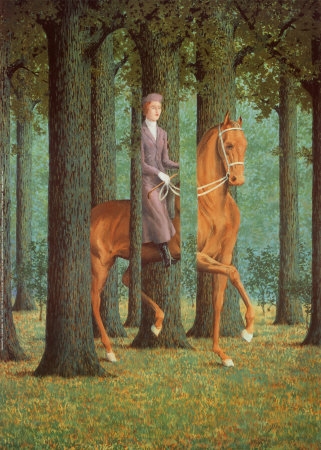
Carte Blanche- 1965
Magritte was a master of illusion and displacement. Above is one good example of illusion done in a more contemporary style several years before his death in 1965.
7) Words and images: Beginning in 1926 magritte began adding written words to his paintings.
Styles
Cubist Pre-1925
Magritte's early work was inspired by the cubists like Fernand Leger and Amedee Ozenfant. After attending a lecture on the Dutch movement by abstractionist Theo van Doesburg titled De Stijl (The Style) in February 1920, Magritte began a series of paintings exploring those principles. Around the same time Servranckx and Magritte developed an artistic style based on purism and futurism they called Cubo-Futurist which in some ways was similar to Art Deco. As you can see in his early works below. Many of these early works seem awkward and primitive. The Nude from 1919 is one of his ealiest works. Around 1925 he abandoned cubism entirely adopting a painterly realtistic style. His important discovery in 1922 was the work of Giorgio de Chirico.
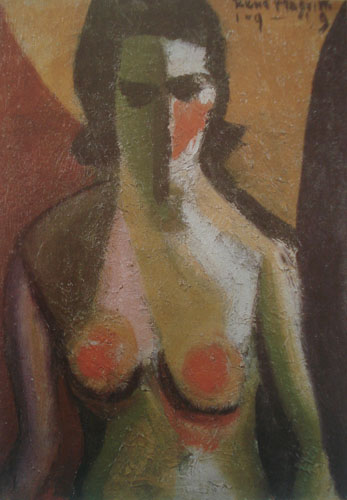
Nude- 1919
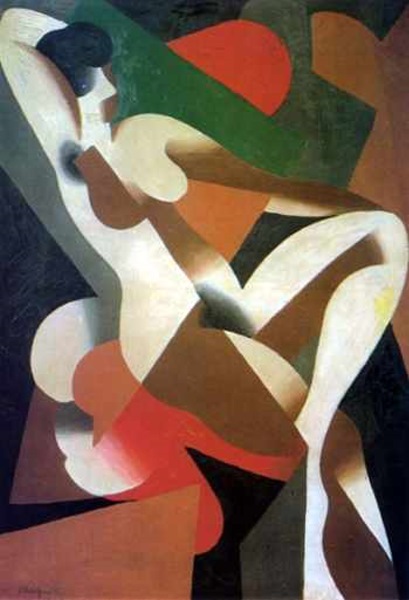
Donna 1923
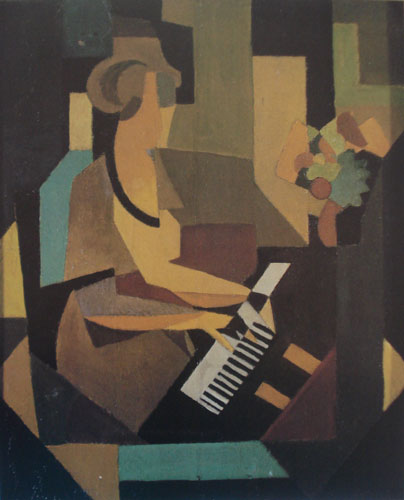
Georgette At The Piano- 1923
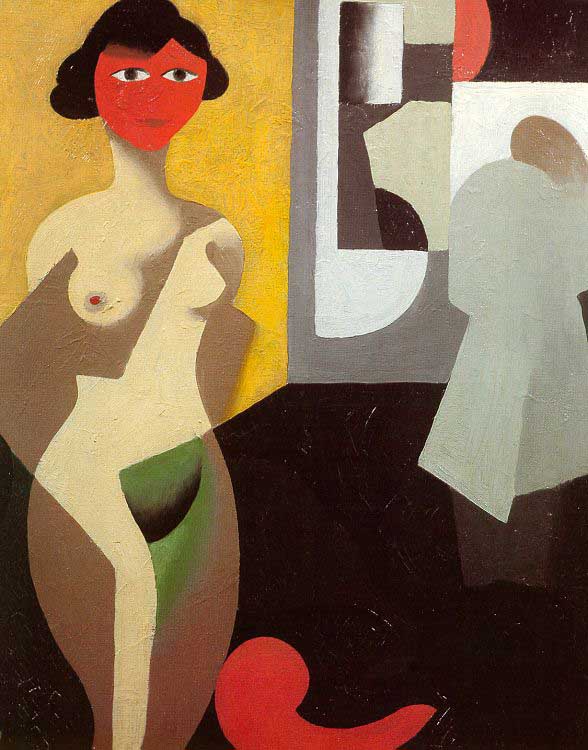
Woman Bathing- 1925
Collage- Early Surrealism and First Iconic Images
Around 1925 Magritte began using collage after Max Ernst. Magritte began using balluster (wooden table leg- bedpost type) icons to represent people and trees. The balluster (bilboquet) icon appears in many of his collages and paintings from this period (1925-1927)

Collage (Untitled) circa 1925: Note that the Bilboquet resembles a chess piece
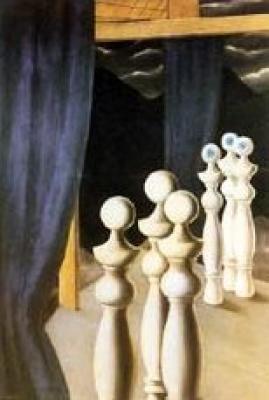
Le Recontre- 1926
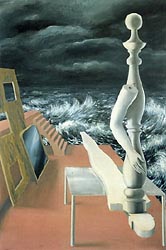
Birth of an Idol
The Treachery of Words
Around 1925 Magritte created a series of paintings that included captions, correctly and incorrectly labeling the image being depicted.